1973 CHEVROLET CAMARO service
[x] Cancel search: servicePage 56 of 84
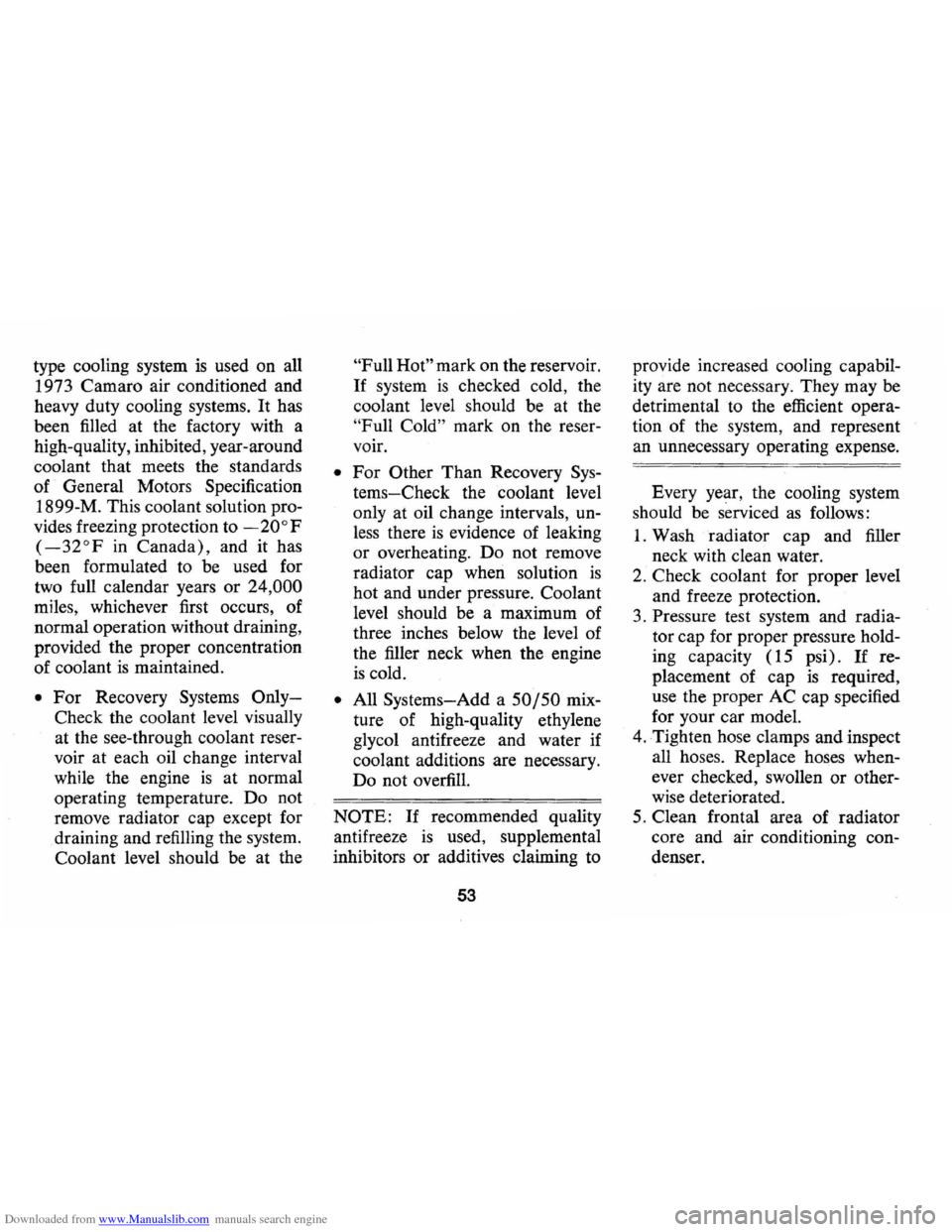
Downloaded from www.Manualslib.com manuals search engine type cooling system is used on all
1973 Camaro air conditioned and
heavy duty cooling systems. It has
been filled at the factory with a
high-quality, inhibited, year-around
coolant that meets the standards
of General Motors Specification
1899-M. This coolant solution pro
vides freezing protection to
-20 0 F
(-32°F in Canada), and it has
been formulated to be used for
two full calendar years
or 24,000
miles, whichever first occurs, of
normal operation without draining,
provided the proper concentration
of coolant
is maintained.
• For Recovery Systems Only
Check the coolant level visually
at the see-through coolant reser
voir at each oil change interval
while the engine
is at normal
operating temperature. Do not
remove radiator cap except for
draining and refilling the system.
Coolant level should be at the
"Full Hot" mark on the reservoir.
If system is checked cold, the
coolant level should be at the
"Full Cold" mark on the reser
voir.
• For Other Than Recovery Sys
tems-Check the coolant level
only at oil change intervals, un
less there
is evidence of leaking
or overheating. Do not remove
radiator cap when solution
is
hot and under pressure. Coolant
level should be a maximum of
three inches below the level of
the filler neck when the engine
is cold.
• All Systems-Add a 50/50 mix
ture of high-quality ethylene
glycol antifreeze and water if
coolant additions are necessary.
Do not overfill.
NOTE: If recommended quality
antifreeze
is used, supplemental
inhibitors or additives claiming to
53
provide increased cooling capabil
ity are not necessary. They may be
detrimental to the efficient opera
tion of the system, and represent
an unnecessary operating expense.
Every year, the cooling system
should be serviced
as follows:
1. Wash radiator cap and filler
neck with clean water.
2. Check coolant for proper level
and freeze protection.
3. Pressure test system and radia
tor cap for proper pressure hold
ing capacity (15 psi).
If re
placement
of cap is required,
use the proper AC cap specified
for your car model.
4. Tighten hose clamps and inspect
all hoses. Replace hoses when
ever checked, swollen
or other
wise deteriorated.
5. Clean frontal area of radiator
core and air conditioning con
denser.
Page 61 of 84
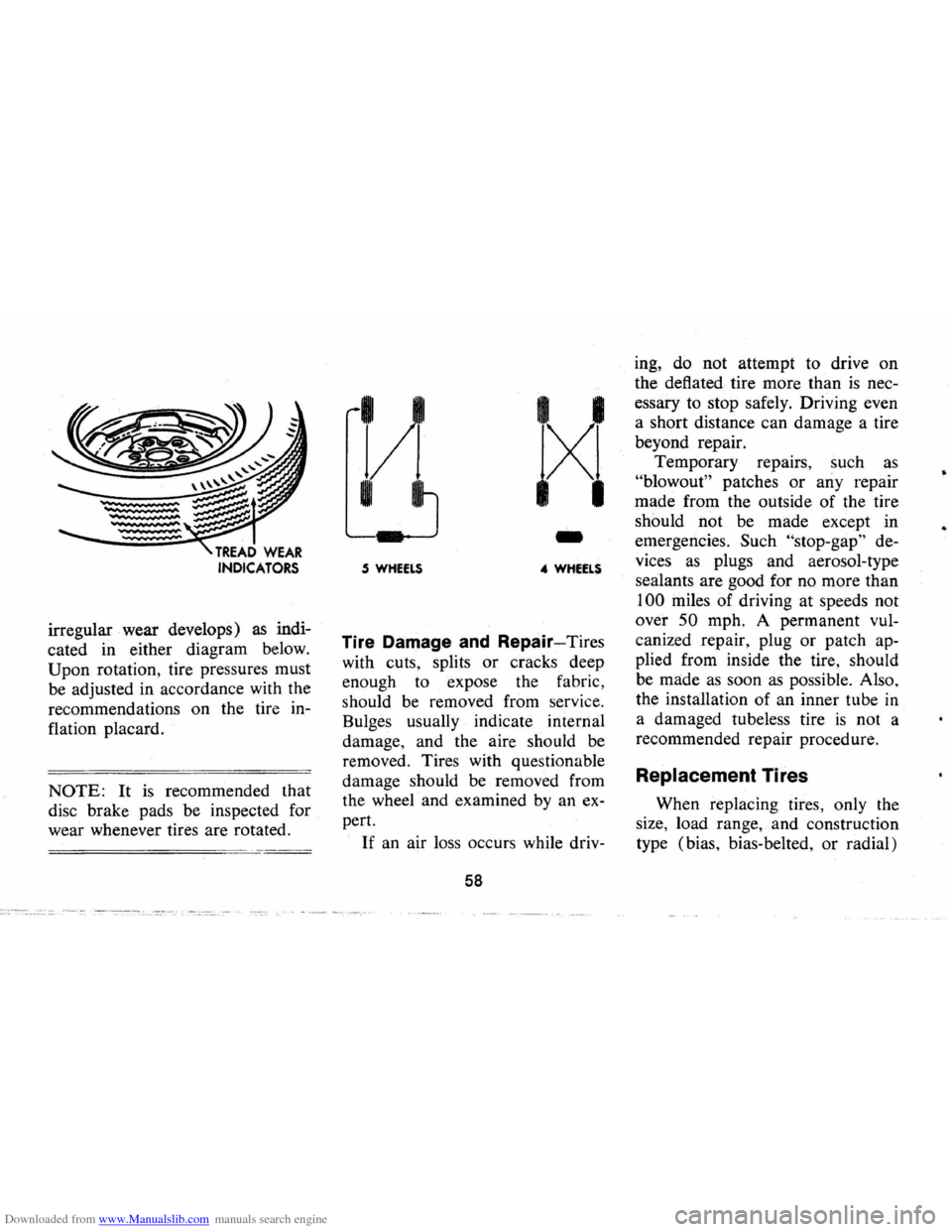
Downloaded from www.Manualslib.com manuals search engine ... ... ... ...
---",,"'"
-..... .
irregular . wear develops) as indi
cated in either diagram below.
Upon rotation, tire pressures must
be adjusted in accordance with the
recommendations on the tire in
flation placard.
NOTE: It is recommended that
disc brake pads be inspected for
wear whenever tires are rotated.
)11
I I
~Xl l.j
-.5 WHEELS 4 WHEELS
Tire Damage and Repair-Tires
with cuts, splits or cracks deep
enough to expose the fabric,
should be removed from service.
Bulges usually indicate internal
damage , and the aire should be
removed. Tires with questionable
damage should be removed from
the wheel and examined
by an ex
pert.
H an air loss occurs while driv-
58
ing, do not attempt to drive on
the deflated tire more than
is nec
essary to stop safely. Driving even
a short distance can damage a tire
beyond repair.
Temporary repairs, such as
"blowout" patches or any repair
made from the outside of the tire
should not be made except in
emergencies.
Such "stop-gap" de
vices
as plugs and aerosol-type
sealants are good for no more than
100 miles of driving at speeds not
over
50 mph. A permanent vul
canized repair, plug or patch ap
plied from inside the tire, should
be
made as soon as possible . Also,
the installation of an inner tube
in
a damaged tubeless tire is not a
recommended repair procedure.
Replacement Tires
When replacing tires, only the
size, load range , and construction
type (bias, bias-belted, or radial)
•
Page 62 of 84
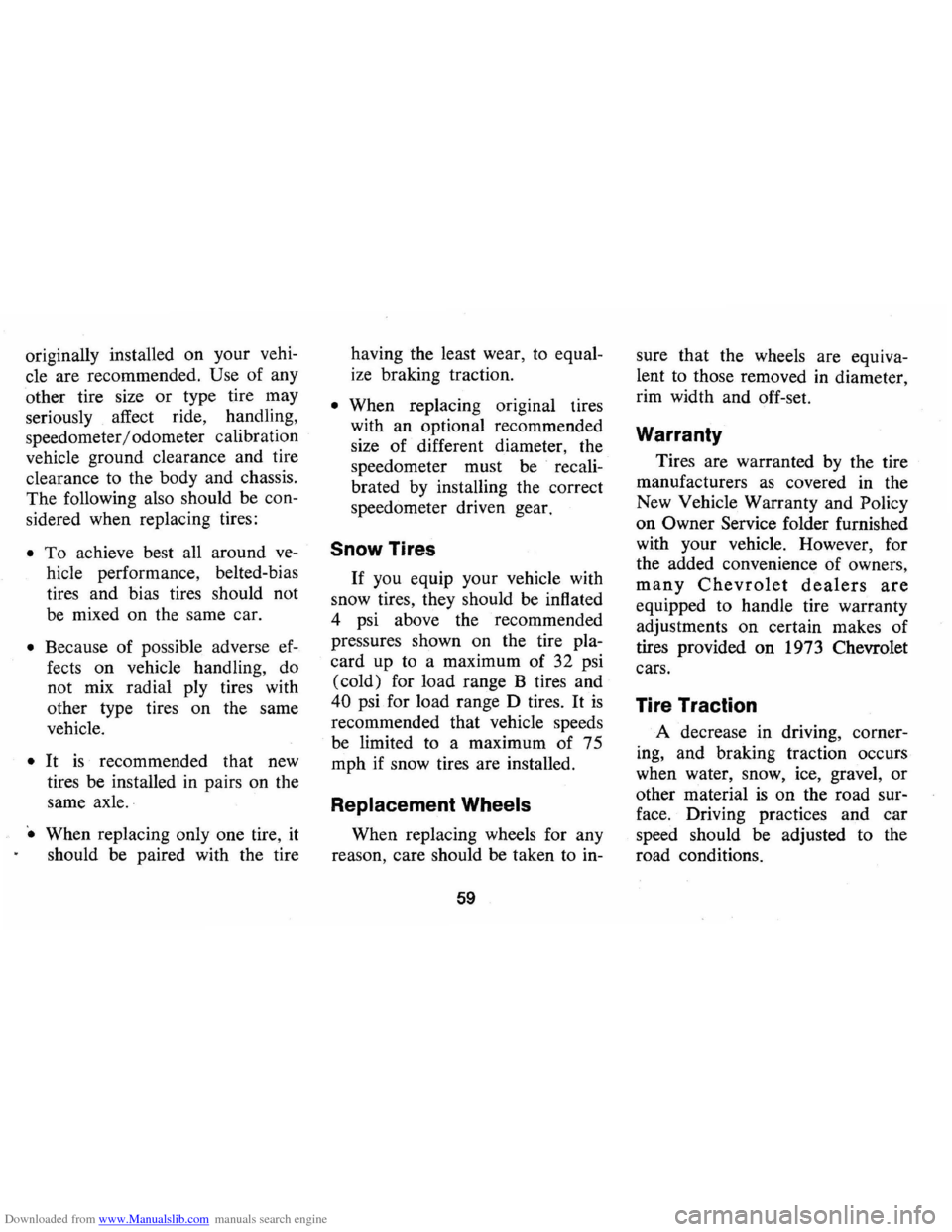
Downloaded from www.Manualslib.com manuals search engine originally installed on your vehi
cle are recommended.
Use of any
other tire size or type tire may
seriously affect ride, handling ,
speedometer / odometer calibration
vehicle ground clearance and tire
clearance to the body and chassis.
The following also should be con
sidered when replacing tires:
• To achieve best all around ve
hicle performance, belted-bias
tires and bias tires should not
be mixed
on the same car.
• Because of possible adverse ef
fects on vehicle handling, do
not mix radial ply tires with
other type tires on the same
vehicle.
• It is recommended that new
tires be installed in pairs on the
same axle.
.. When replacing only one tire, it
should be paired with the tire having
the least wear, to equal
ize braking traction.
• When replacing original tires
with an optional recommended
size of different diameter, the
speedometer must be recali
brated by installing the correct
speedometer driven gear.
Snow Tires
If you equip your vehicle with
snow tires, they should be inflated
4 psi above the recommended
pressures shown on the tire pla
card up to a maximum of 32 psi
( cold) for load range B tires and
40 psi for load range D tires. It is
recommended that vehicle speeds
be limited to a maximum of 75
mph if snow tires are installed.
Replacement Wheels
When replacing wheels for any
reason, care should be taken to in-
59
sure that the wheels are equiva
lent to those removed in diameter,
rim width and off-set.
Warranty
Tires are warranted by the tire
manufacturers
as covered in the
New Vehicle Warranty and Policy
on Owner Service folder furnished
with your vehicle. However, for
the added convenience of owners,
many Chevrolet dealers are
equipped to handle tire warranty
adjustments
on certain makes of
tires provided
on 1973 Chevrolet
cars.
Tire Traction
A decrease in driving, corner
ing, and braking traction occurs
when water, snow, ice, gravel,
or
other material is on the road sur
face. Driving practices and car
speed should be adjusted to the
road conditions.
Page 64 of 84
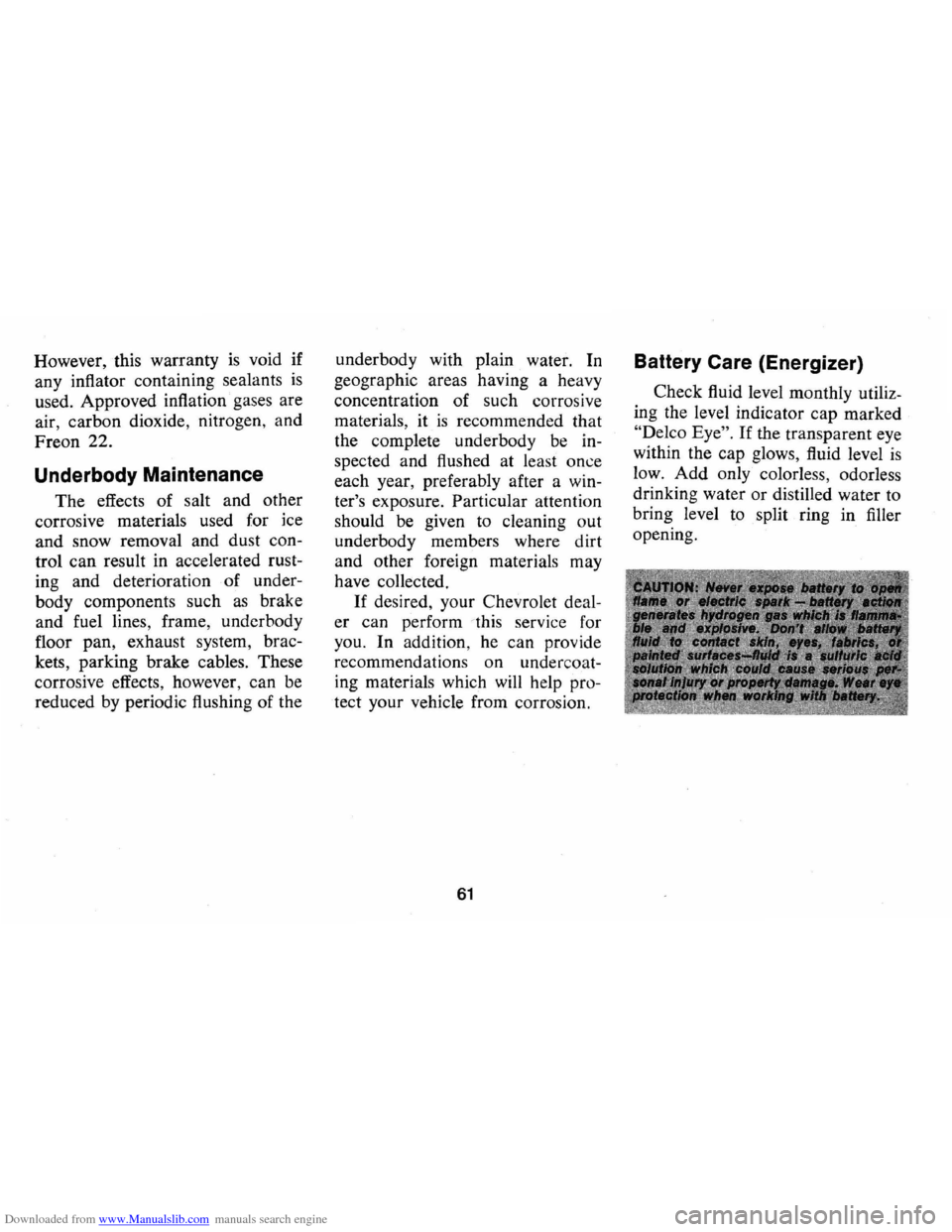
Downloaded from www.Manualslib.com manuals search engine However, this warranty is void if
any inflator containing sealants
is
used. Approved inflation gases are
air, carbon dioxide, nitrogen, and
Freon 22.
Underbody Maintenance
The effects of salt and other
corrosive materials used for ice
and snow removal and dust con
trol can result in accelerated rust
ing and deterioration of under
body component s such
as brake
and fuel lines, frame, underbody
floor pan, exhaust system, brac
kets, parking brake cables. These
corrosive effects, however , can be
reduced
by periodic flushing of the underbody
with plain water. In
geographic areas having a heavy
concentration of such corrosive
materials, it
is recommended that
the complete underbody be in
spected and flushed at least
once
each year, preferably after a win
ter's exposure.
Particular attention
should be given to cleaning out
underbody members where dirt
and other foreign materials may
have collected .
If desired, your Chevrolet deal
er can perform
this service for
you. In addition , he can provide
recommendations on undercoat
ing materials which will help pro
tect your vehicle from corrosion.
61
Battery Care (Energizer)
Check fluid level monthly utiliz
ing the level indicator cap marked
"Delco Eye". If the transparent eye
within the cap glows, fluid level
is
low. Add only colorless, odorless
drinking water or distilled water to
bring level to split ring in filler
opening.
Page 67 of 84

Downloaded from www.Manualslib.com manuals search engine IE) If the car will start but stalls when hot or has a rough idle,
you can suspect a faulty IDLE ADJUSTMENT, a malfunctioning AUTOMATIC CHOKE or an extremely dirty and blocked AIR CLEANER ELEMENT. Replace paper element air cleaner if necessary. Idle adjustment or automatic choke service (other than that outlined in paragraph 0 above) should be performed by your
Chevrolet Dealer.
If the above Fuel System checks and the checks suggested under the Electrical System following do not correct the malfunction, it is recommended that you return to your Authorized Chevrolet Dealer
for further checks, adjustments or repairs.
ELECTRICAL SYSTEM If, when the ignition key is turned to "Start", the engine will not
turn over, you have good reason to suspect electrical trouble. NOTE: Never remove Delcotron bat lead without first disconnecting
battery ground cable.
IF) When there is no response at all to attempts to start the car, check the obvious-your AUTOMATIC TRANSMISSION SELECTOR LEVER must be in Neutral or Park position (manual transmission
must have clutch depressed all the way to floor) before the engine can be started. Turning the IGNITION SWITCH rapidly back and forth several times will sometimes correct a poor internal switch
contact.
IG) The BATIERY may be discharged. If so, lights will be dim and the horn will have a poor tone if it will blow at all.
Usually a garage recharge will be necessary to return the battery to operation. Occasionally, however, a long drive will recharge the battery. NOTE: If the battery is determined to be dead, and for no apparent reason, have your Authorized Chevrolet Dealer check the
battery, the GENERATOR and the VOLTAGE REGULATOR.
GENERATOR trouble should already have been indicated by the generator indicator light on the instrument panel.
64
POOR BATIERY CONNECTIONS may be suspected if the car has operated properly a short time before and now not even the horn
will operate. Check both ends of both battery cables. If the connections are corroded, a car may sometimes be restored to operation by removing all cable ends, scraping all contacting surfaces
clean with a pen knife, and reassembling. If the cables are broken,
they must be replaced. The power supply should now be restored
unless the battery is dead.
IH) If, however, the lights and horn work properly but the starter will still not turn over, check the STARTER connections. A "click" from the starter solenoid indicates that the wiring to the starter is properly installed. If the wiring seems to be clean and tightly in
stalled, the trouble is probably in the starter itself and should be referred to your Authorized Chevrolet Dealer.
When the engine will
"turn over" but will not start, the foilowing
items may be checked along with the Fuel Systems Checks listed
previously.
II) With a clean dry cloth, wipe the ceramic portions of the spark plugs dry. In particularly damp or rainy weather dampness may be
the cause of not sta rting, especi
ally when the engine is cold.
IJ) Check the cables at the top of the distributor and coil as well as each spark plug cable for
tightness.
IK) If the co r will still not sta rt,
check for spark at the spark plugs in the following manner:
Pull one of the spark plug
wires off its spark plug. Insert a
short piece of bare wire (such as Di.,ribu'or and Coil Cab I ••
Page 73 of 84
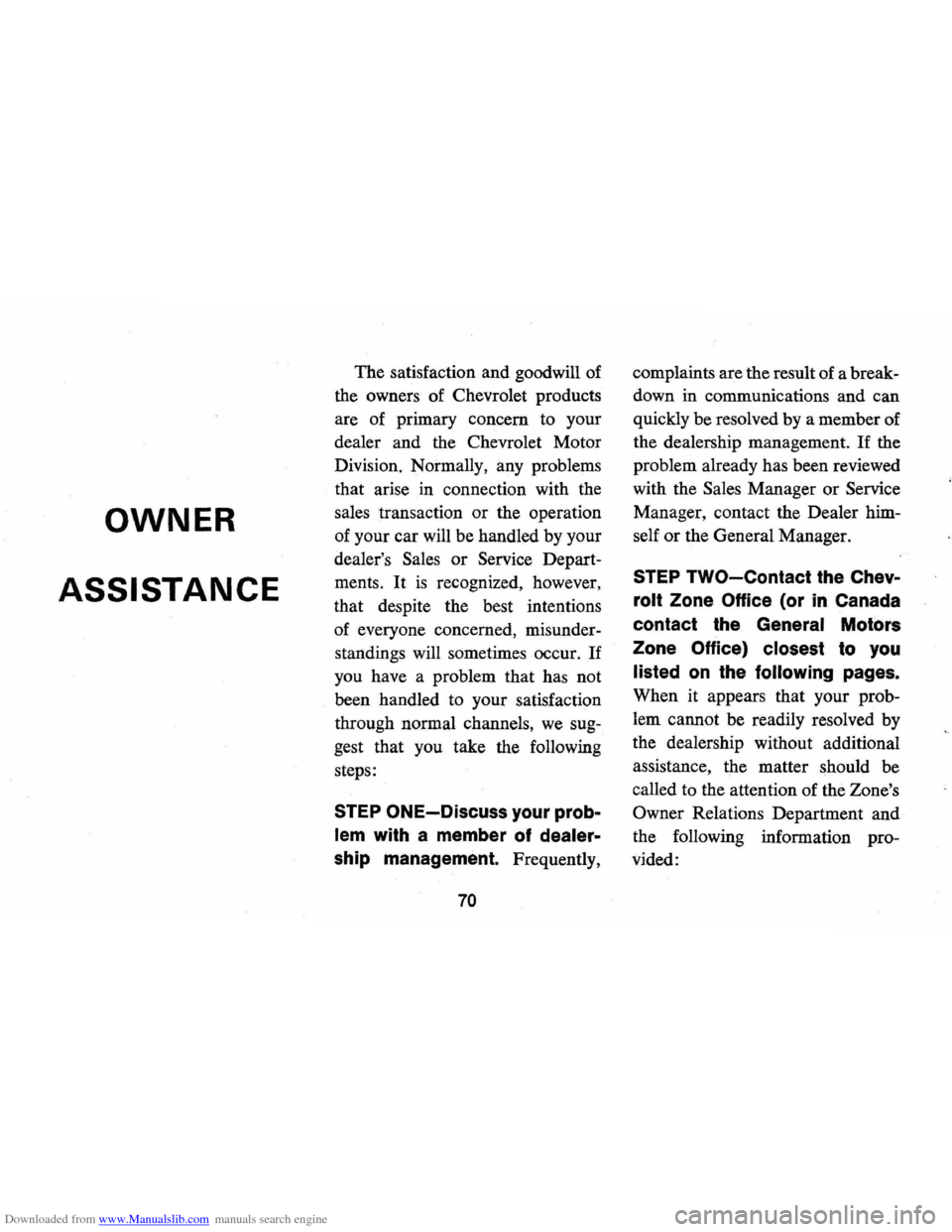
Downloaded from www.Manualslib.com manuals search engine OWNER
ASSISTANCE
The satisfaction and goodwill of
the owners of Chevrolet products
are of primary concern to your
dealer and the Chevrolet Motor
Division. Normally, any problems
that arise in connection with the
sales transaction
or the operation
of your car will be handled by your
dealer's
Sales or Service Depart
ments.
It is recognized, however,
that despite the best intentions
of everyone concerned, misunder
standings will sometimes occur.
If
you have a problem that has not
been handled to your satisfaction
through normal channels,
we sug
gest that you take the following
steps:
STEP ONE-Discuss your prob
lem with a member of dealer
ship management. Frequently,
70
complaints are the result of a break
down in communications and can
quickly be resolved by a member of
the dealership management.
If the
problem already has been reviewed
with the
Sales Manager or Service
Manager, contact the Dealer him
self or the General Manager.
STEP TWO-Contact the Chev
rolt Zone Office (or in Canada
contact
the General Motors
Zone
Office) closest to you
listed on the following pages.
When it appears that your prob
lem cannot be readily resolved by
the dealership without additional
assistance, the matter should be
called to the attention of the Zone's
Owner Relations Department and
the following information pro
vided:
Page 74 of 84
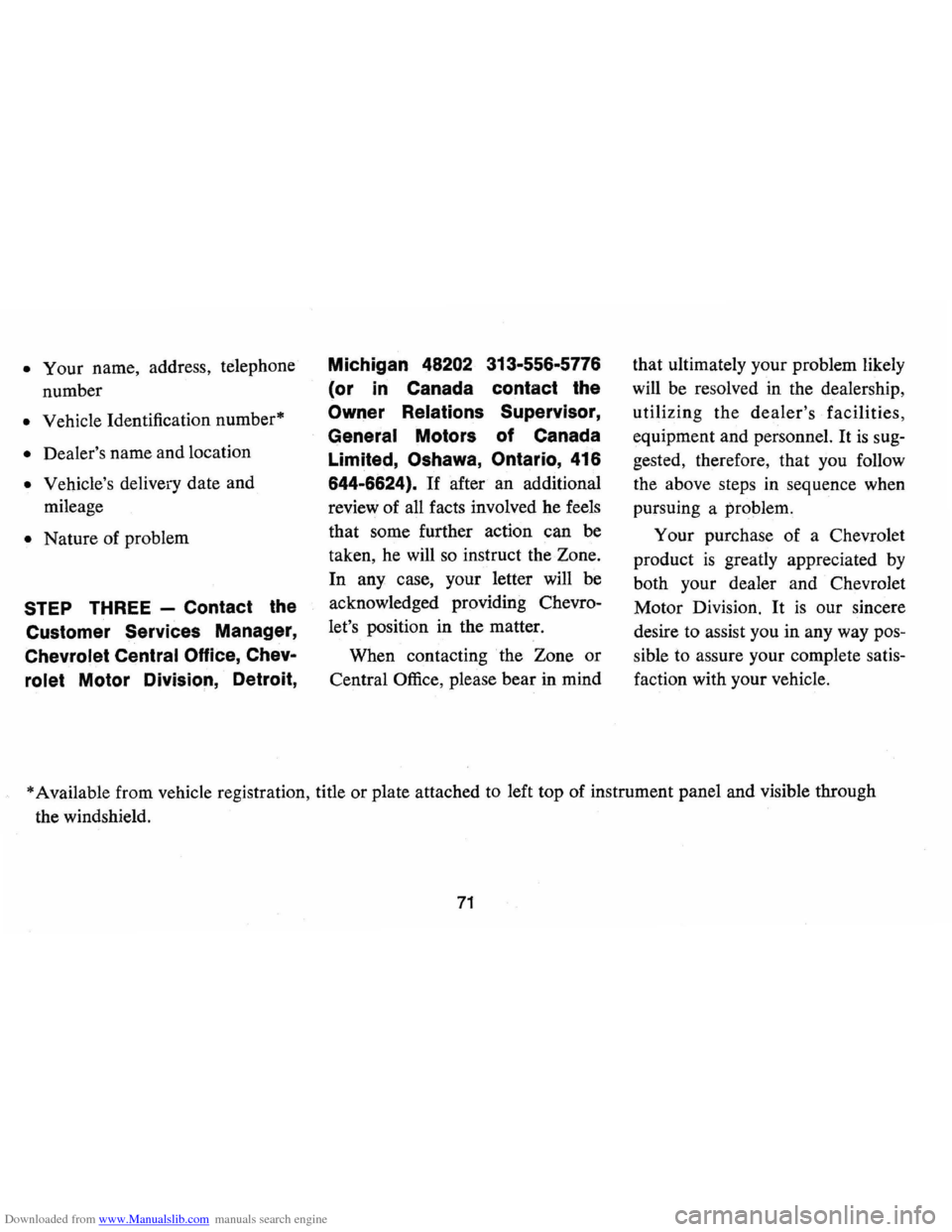
Downloaded from www.Manualslib.com manuals search engine • Your name, address, telephone
number
• Vehicle Identification number*
• Dealer's name and location
• Vehicle's delivery date and
mileage
• Nature of problem
STEP THREE -Contact the
Customer Services Manager,
Chevrolet Central Office, Chev
rolet Motor Division, Detroit, Michigan
48202 313-556-5776
(or
in Canada contact the
Owner Relations Supervisor,
General Motors of Canada
Limited, Oshawa, Ontario, 416
644-6624).
If after an additional
review of all facts involved he feels
that some further action can be
taken, he will
so instruct the Zone.
In any case, your letter will be
acknowledged providing Chevro
let's position in the matter.
When contacting the Zone or
Central
Office, please bear in mind that
ultimately your problem likely
will be resolved in the dealership,
utilizing the
dealer's facilities,
equipment and personnel.
It is sug
gested, therefore, that you follow
the above steps in sequence when
pursuing a problem.
Your purchase of a Chevrolet
product
is greatly appreciated by
both your dealer and Chevrolet
Motor Division.
It is our sincere
desire to assist you in any way pos
sible to assure your complete satis
faction with your vehicle.
* Available from vehicle registration, title or plate attached to left top of instrument panel and visible through
the windshield.
71
Page 75 of 84
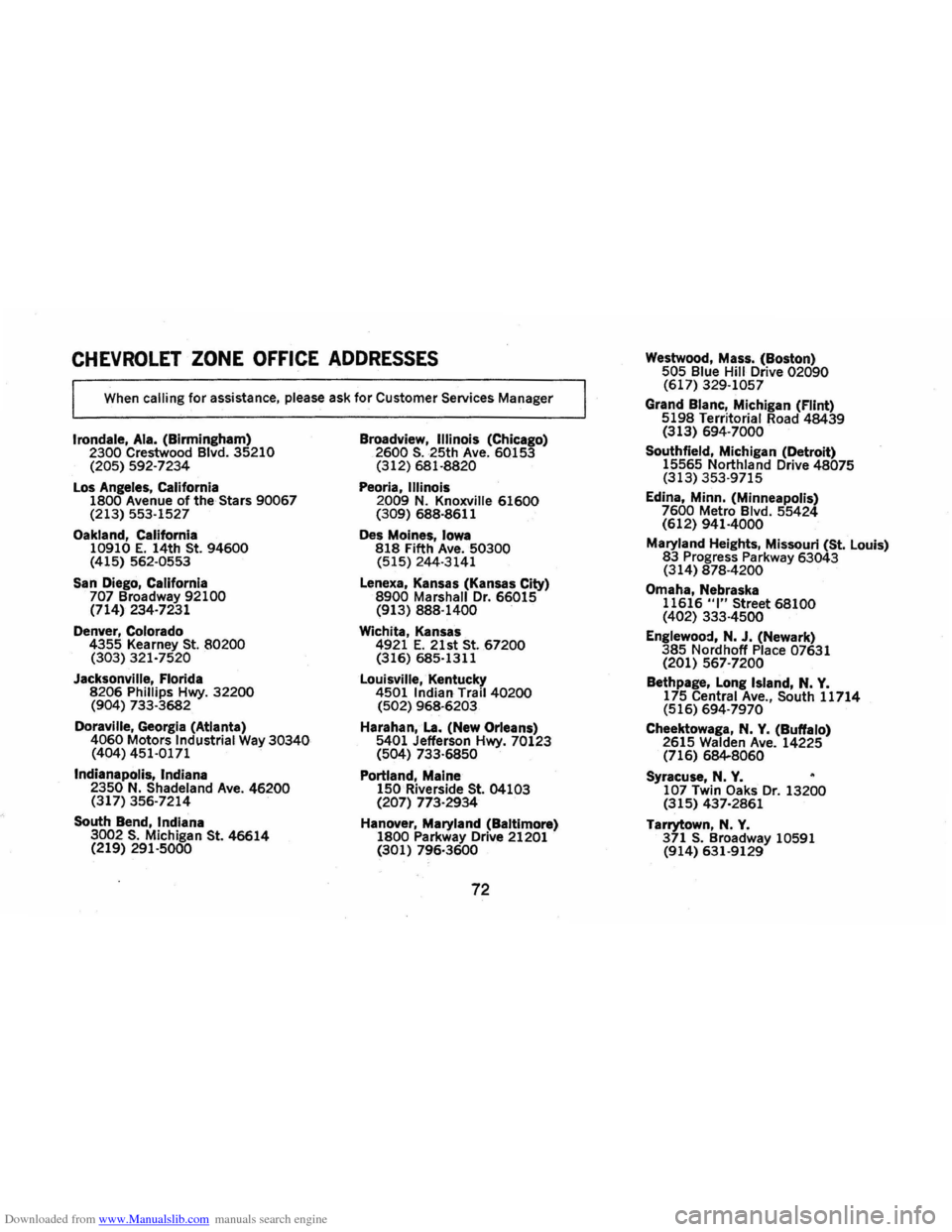
Downloaded from www.Manualslib.com manuals search engine CHEVROLET ZONE OFFICE ADDRESSES
When calling for assistance, please ask for Customer Services Manager
Irondale, Ala. (Birmingham) 2300 Crestwood Blvd. 35210
(205) 592-7234
Los Angeles,
California
1800 Avenue of the Stars 90067 (213) 553-1527
Oakland,
California
10910 E. 14th St. 94600 (415) 562·0553
San Diego, California
707 Broadway 92100 (714) 234-7231
Denver, Colorado
4355 Kearney
St. 80200
(303) 321-7520
Jacksonville, Florida 8206 Phillips Hwy. 32200
(904) 733-3682
Doraville, Georgia (Atlanta)
4060 Motors Industrial Way 30340 (404) 451-0171
Indianapolis, Indiana
2350
N. Shadeland Ave. 46200 (317) 356-7214
South Bend,
Indiana
3002 S. Michigan St. 46614
(219) 291-5000
Broadview, Illinois (Chicago) 2600 S. 25th Ave. 60153 (312) 681-8820
Peoria, Illinois
2009 N. Knoxville 61600 (309) 688-8611
Des Moines,
Iowa 818 Fifth Ave. 50300 (515) 244·3141
Lenexa, Kansas (Kansas City)
8900 Marshall Dr. 66015 (913) 888-1400
Wichita, Kansas
4921 E. 21st St .. 67200 (316) 685-1311
Louisville, Kentucky
4501 Indian Trail 40200
(502) 968-6203
Harahan,La. (New Orleans) 5401 Jefferson Hwy. 70123
(504) 733-6850
Portland, Maine 150 Riverside St. 04103
(207) 773-2934
Hanover, Maryland (Baltimore)
1800 Parkway Drive 21201
(301) 796·3600
72
Westwood, Mass. (Boston) 505 Blue Hill Drive 02090 (617) 329·1057
Grand Blanc, Michigan (Flint)
5198 Territorial Road 48439
(313)
694- 7000
Southfield,
Michigan (Detroit)
15565 Northland Drive 48075 (313) 353·9715
Edina, Minn. (Minneapolis)
7600 Metro Blvd. 55424
(612) 941-4000
Maryland Heights, Missouri (St. Louis)
83 Progress Parkway 63043 (314) 878·4200
Omaha, Nebraska
11616 "I" Street 68100
(402) 333·4500
Englewoo:t,
N. J. (Newark)
385 Nordhoff Place 07631
(201) 567·7200
Bethpage, Long Island, N. Y. 175 Central Ave., South 11714
(516) 694-7970
Cheektowaga, N. Y. (Buffalo) 2615 Walden Ave_ 14225
(716) 684--8060
Syracuse,
N. Y. 107 Twin Oaks Dr. 13200 (315) 437-2861
Tarrytown, N.
Y. 371 S. Broadway 10591 (914) 631·9129